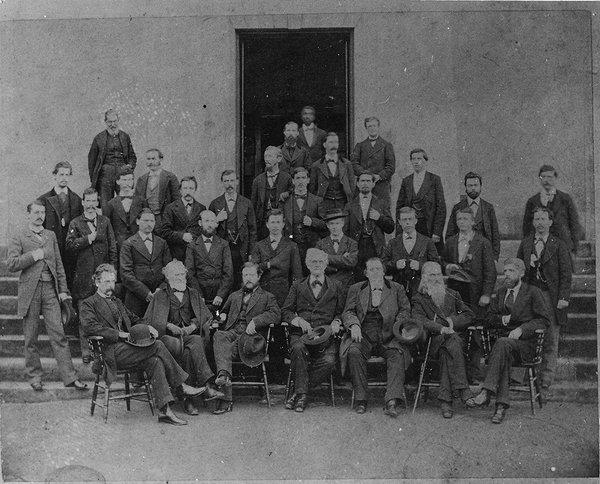This is how U.S. colleges stole freshly-buried black corpses in the 1830s for study. Construction workers renovating an old building in Augusta, Georgia made a shocking discovery in the summer of 1989 – 10,000 bones buried in a basement under the dirt in the building
The bones revealed a dark history – grave robbing of African-American bodies from the 18th to the 20th centuries. Markings from the bones showed that they came from dissected bodies, and the building in which they had been hidden was the former home of the Medical College of Georgia
Known as the Old Medical College Building, it was used as a lecture hall and laboratory space from 1835 until 1913, and for these number of years, students learned about the anatomy from bodies of largely once enslaved black people stolen from graves.
According to accounts, dissection was, for the most part of the 19th century, illegal in many parts of the United States. This made it difficult for medical students to learn human anatomy, hence, colleges had to resort to the secret and illegal practice of grave robbing.

This was usually carried out by people known as body snatchers who were mostly slaves, employees, or even students of the colleges.
Such was the case in the Old Medical College Building in Georgia. Since dissection of bodies was illegal until 1887, school authorities relied on bodies from body snatchers and even kept one full-time in their apartment, according to Atlas Obscura.
Grandison Harris, a 36-year-old Gullah slave who was purchased by the medical college in a slave auction in 1852 in Charleston, South Carolina, was the main person behind grave robbing for the school.

It was against the law to teach slaves how to read or write, but the doctors taught Harris how to read and write because that would be very essential for his role.
Owned by the entire faculty of the school, Harris worked as a porter, janitor, teaching assistant and a body snatcher. With the education given him, Harris would read the obituaries and other death notices in newspapers to find out who had died and when they would be buried
Augusta’s Cedar Grove Cemetery was then the main cemetery for black people at the time. If someone was to be buried, Harris would, late at night, take his cart, sack and shovel.
“He would quietly go into the cemetery and find the grave. He would look and remember how everything was and then dig down to the body. If the body was in a casket, Grandison would break into the end of the casket. Then with a firm grip, and strong-arms he would pull the body out. He would then put the body into a bag and load it on his cart. Grandison Harris would then put everything back on the grave, in its original position. People could not tell the grave had been tampered with. At that time, he would roll the cart back to the Medical College on Telfair Street. The bodies would be dissected and used to teach the students about the human body,” writes augustagahistory.com.

Security was not tight at the Cedar Grove Cemetery as it was mainly for poor black people who were interred in “flimsy coffins.” Becoming known as the “Resurrection Man,” the medical school would use Harris to get cadavers for the students to dissect them throughout his period at the facility.
Even when Georgia passed a law to give medical colleges legal cadavers, Harris had to continue robbing the graves of black communities as demand excelled supply
The practice ceased in 1889 when the African-American residents of Augusta found out and almost rioted at the school premises. After more than a century, the matter was resurrected when the construction workers found the bones in the basement of the building.
According to authorities, 350 to 450 people, mostly African-Americans, were buried there. Some of the bones had specimen numbers written on them. The workers also found a large wooden vat holding dozens of bones while another vat held body parts still preserved in whiskey
It is reported that when the students dissected the bodies, they were buried in the college building and lime was used to cut down the smell.
The Medical College of Virginia (MCV) at Virginia Commonwealth University was another culprit in grave robbing. Employing the services of resurrection men, the school, then known as Hampden-Sydney College, stole dead bodies from African American cemeteries until the 20th century
After the students had worked on them, the body snatchers threw what was left in an old well below East Marshall Street that became known as the “limb pit.” When the well was discovered in 1994, an analysis showed that it contained at least 44 adults and nine children, and these were mostly of people of African American descent.
Students at Harvard Medical School were also reported to have used the services of resurrection men to supply their labs with dead bodies. In 1999, human remains were found in Holden Chapel that was home to the medical school in 1801. The building was used for anatomy lectures until 1850.

Even though Massachusetts passed a law in 1831 that allowed the state’s medical schools to acquire bodies that belonged to those who died in prison, the poor, or the insane, graves of black folks were still robbed
It is not known if the bones found in the chapel that housed the school was reinterred. What is documented is that the bones from the Medical College of Georgia were laid to rest in a mass grave at the Cedar Grove Cemetery in 1998
The VCU community created the East Marshall Street Well Project to encourage a continuous study of the remains.










